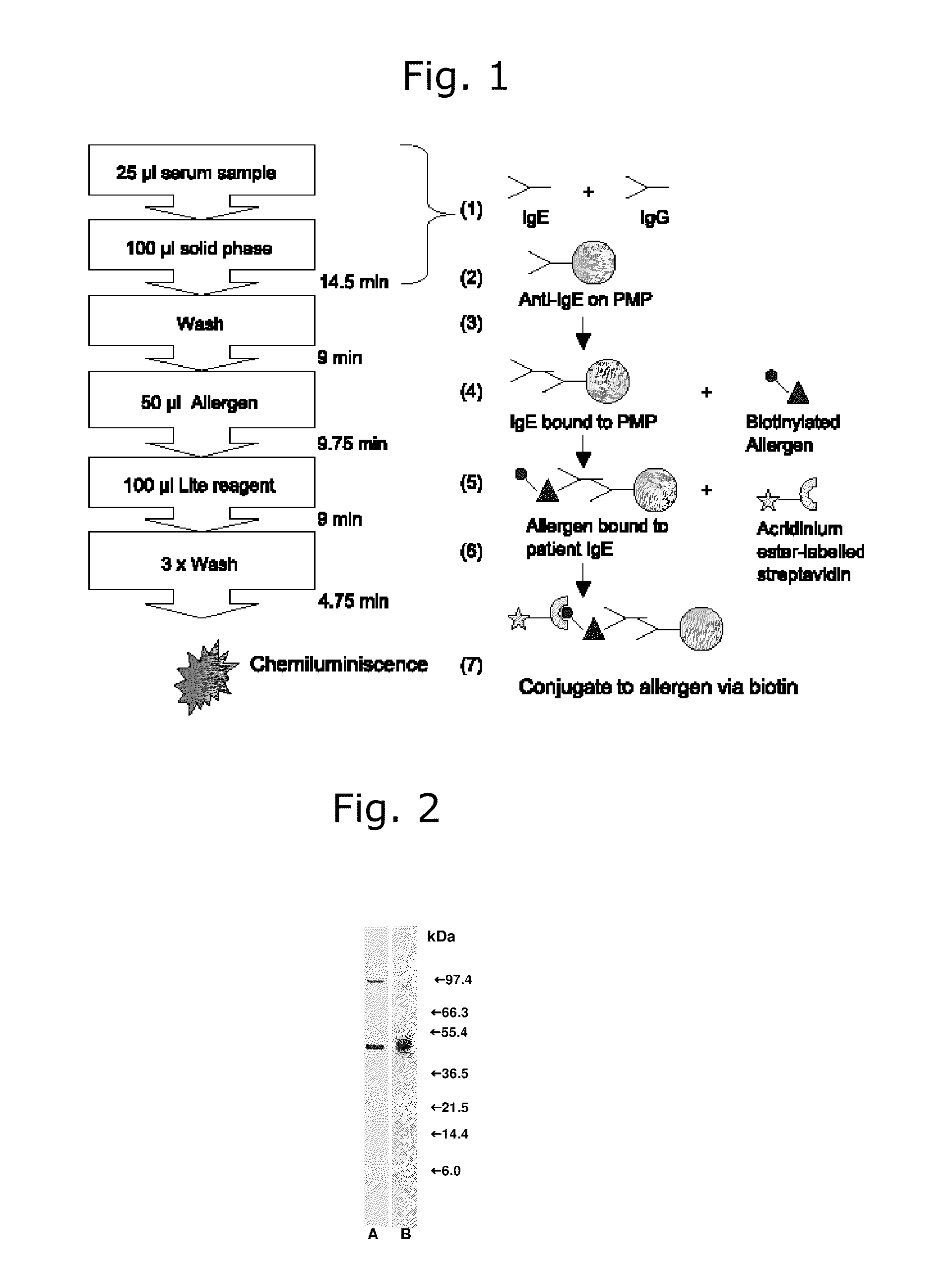Minor allergen control to increase safety of immunotherapy
a technology of immunotherapy and minor allergens, applied in the field of immunology and allergology, can solve problems such as undesirable side effects, and achieve the effect of increasing safety
- Summary
- Abstract
- Description
- Claims
- Application Information
AI Technical Summary
Benefits of technology
Problems solved by technology
Method used
Image
Examples
example 1
[0154]This example describes the different patterns of sensitization to two allergens from olive tree pollen (the major allergen Ole e 1 and the minor allergen Ole e 9) shown by patients living in areas with high or low level of exposure to airborne olive tree pollen and the variability of olive tree pollen batches regarding the concentration of these allergens, including the description of a new method to measure the concentration of Ole e 9 in olive tree pollen extracts.
[0155]Olive tree pollen is one of the most important causes of respiratory allergies in the Mediterranean region and some areas of North America (12, 13). Ten different allergens have been identified in olive tree pollen up to date (14, 15). All the authors agree on the identification of Ole e 1 as the most important allergen (14, 16, 17, 18). However, for the rest of allergens, prevalence data are controversial, since a number of factors, such as population selected, analytical methods and reagents used to perform...
example 2
[0186]This example describes the variability of the concentration of the allergen Phl p 6 in extracts from Phleum pratense pollen and the close immunochemical relationship of this allergen with the cross-reactive major allergen Phl p 5. A new ELISA method to measure the concentration of Phl p 6 in pollen extracts that may be applied for the control of this allergen in allergy vaccines is presented.
[0187]Grass pollens are one of the most important airborne allergen sources worldwide. Allergic sensitization to grass pollen may affect as many as 20% of the general population and up to 40% of atopic individuals (31). To date, eleven different groups of grass pollen allergens have been identified and characterized from one or more species. Group 5 grass pollen allergens have been identified in many members of the Pooideae subfamily and, together with Group 1 allergens, they are the most prominent allergens of grass pollen (31). Group 6 grass pollen allergens have been identified only in ...
example 3
[0201]This example describes the variability in the individual responses of patients allergic to the mould Alternaria alternata. This example is presented only to show that individual patients may produce a strong IgE-response to minor allergens in a number of different allergenic extracts, apart from those mentioned in the previous examples. Consequently, the concentration of such allergens should be controlled by adequate quantitation methods to minimize the risk of adverse reactions.
[0202]Allergenic mould extracts show a high variability as a result of their intrinsic complexity. The type of fungal strain, different culture conditions and different extraction procedures are the most important causes of such heterogeneity. Ten different allergens have been identified so far (43). The only allergen described with a frequency of sensitization higher than 50% is Alt a 1 (43). The present inventors developed a mAb-based ELISA method to quantify this allergen (44). Nevertheless, from t...
PUM
| Property | Measurement | Unit |
|---|---|---|
| water content | aaaaa | aaaaa |
| temperatures | aaaaa | aaaaa |
| pH | aaaaa | aaaaa |
Abstract
Description
Claims
Application Information
 Login to View More
Login to View More - R&D
- Intellectual Property
- Life Sciences
- Materials
- Tech Scout
- Unparalleled Data Quality
- Higher Quality Content
- 60% Fewer Hallucinations
Browse by: Latest US Patents, China's latest patents, Technical Efficacy Thesaurus, Application Domain, Technology Topic, Popular Technical Reports.
© 2025 PatSnap. All rights reserved.Legal|Privacy policy|Modern Slavery Act Transparency Statement|Sitemap|About US| Contact US: help@patsnap.com



